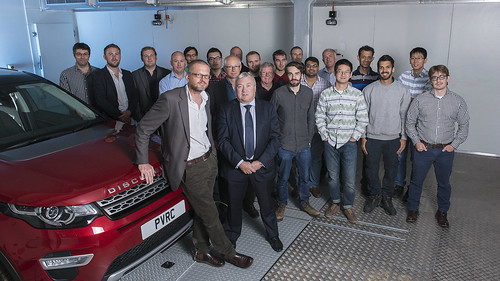The newly installed Dynamometer, commonly known as a rolling road aims to bridge the gap between the lab and the real world by allowing vehicles to be analysed in a series of real-world driving conditions, but within a precisely controlled laboratory environment.
Far reaching capabilities
This ground breaking CLEVeR facility has far reaching experimental capabilities. In addition to the four wheel drive dynamometer, the facility is able to analyse vehicle performance at a range of temperatures (from -10ºC through to +50ºC), vary the humidity of the driving conditions, and carry out state-of-the-art emission measurements, ensuring that the emissions from cars out on the open road are not different to those established by traditional laboratory analysis.
This is essential with EU targets for automotive emissions demanding a 40 per cent reduction in CO₂by 2020, based on 2007 levels.
The facility will also conduct analysis using a robotic driver which can be programmed to perform a range of driving styles to reflect everyday varying driver behaviour which can significantly affect the fuel efficiency and emissions of vehicles. This is vital to allow accurate, repeatable analysis of vehicle performance.
Hybrid vehicles can also be examined using the dynamometer, with two power supply racks for battery emulation, giving faster analysis with highly repeatable results in a safe environment.
Established track record
The University of Bath has an established track record in delivering world class automotive research. This highly significant facility is the result of a £1.8m equipment funding award from the Engineering & Physical Sciences Research Council (EPSRC), and £600,000 from the University of Bath.
Part of the PVRC
CLEVeR is the flagship facility within the University’s Powertrain & Vehicle Research Centre (PVRC). As part of the Department of Mechanical Engineering, the PVRC is one of the leading UK university groups in this field, spanning four decades of achievement and extensive engagement with the automotive industry.
Conducting internationally prize-winning research, focusing on improving the efficiency and emissions of both diesel and petrol engines, the PVRC has a wide range of industrial collaborators and funding bodies including Jaguar Landrover, Ford, EPSRC, First, AshWoods and Lotus, to name just a few.
Conducting future R&D
CLEVeR will be fully operational in October 2015 and has been created to establish a UK centre of excellence in low carbon vehicle research. Drawing upon the experience and expertise from some of the University’s leading academics and researchers, many of whom are part of the PVRC, CLEVeR will be undertaking collaborative R&D investigations with a number of the industry’s leading companies.
The expertise of staff working within the PVRC and CLEVeR are wide ranging and include diesel engine combustion; turbocharging and air charge management; alternative fuels and emissions after treatment; modelling and optimisation; and hybrid and electric powertrain systems.
Recognising the need to ensure the next generation of engineers can continue to keep pushing the limits of research and development, the University also has taken on a number of high quality PhD students and research associates to help work on topical and current issues in automotive research.
Opening new avenues
Professor Gary Hawley, lead investigator for CLEVeR and Dean of the University of Bath’s Faculty of Engineering & Design, said: “This unique new facility will open avenues of automotive research that were not previously possible. We have established a platform where fundamental academic research can be undertaken alongside applied industry investigations in a world-class environment. CLEVeR will address many of the future research challenges associated with current and future low and ultra-low carbon vehicles under real world driving conditions.”
Professor of Automotive Propulsion and Deputy Director of the University’s PVRC Chris Brace commented: “I’m really excited about this opportunity to do new research to investigate real world usage and driver behavior effects in a laboratory setting.”


